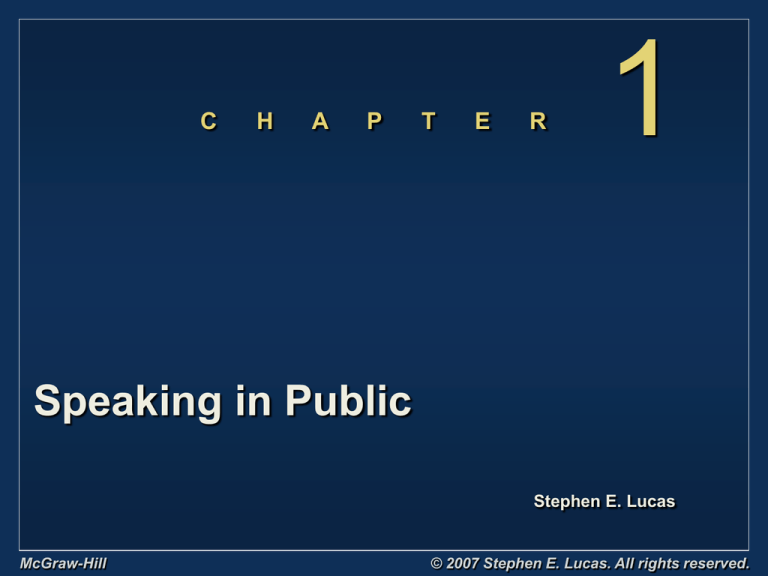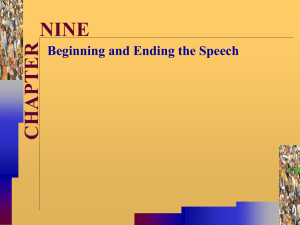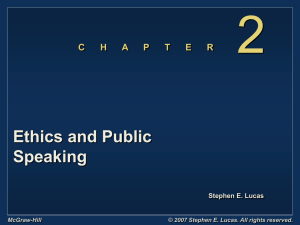
C
H
A
P
T
E
R
1
Speaking in Public
Stephen E. Lucas
McGraw-Hill
© 2007 Stephen E. Lucas. All rights reserved.
Slide 2
Similarities Between Public
Speaking and Conversation
• Organizing thoughts logically
• Tailoring the message to the
audience
• Telling a story for maximum impact
• Adapting to listener feedback
McGraw-Hill
© 2007 Stephen E. Lucas. All rights reserved.
Slide 3
Differences Between Public
Speaking and Conversation
• Public speaking is more highly
structured
• Public speaking requires more
formal language
• Public speaking requires a
different method of delivery
McGraw-Hill
© 2007 Stephen E. Lucas. All rights reserved.
Slide 4
The Speech Communication
Process
•
•
•
•
•
•
•
McGraw-Hill
Speaker
Message
Channel
Listener
Feedback
Interference
Situation
© 2007 Stephen E. Lucas. All rights reserved.
Slide 5
Speaker
The person who is presenting an
oral message to a listener.
McGraw-Hill
© 2007 Stephen E. Lucas. All rights reserved.
Slide 6
Message
Whatever a speaker communicates
to someone else.
McGraw-Hill
© 2007 Stephen E. Lucas. All rights reserved.
Slide 7
Channel
The means by which a message is
communicated.
McGraw-Hill
© 2007 Stephen E. Lucas. All rights reserved.
Slide 8
Listener
The person who receives the
speaker’s message.
McGraw-Hill
© 2007 Stephen E. Lucas. All rights reserved.
Slide 9
Frame of Reference
The sum of a person’s knowledge,
experience, goals, values, and
attitudes.
McGraw-Hill
© 2007 Stephen E. Lucas. All rights reserved.
Slide 10
Frame of Reference
• Everything a speaker says is
filtered through a listener’s frame
of reference.
• No two people can have exactly
the same frame of reference.
McGraw-Hill
© 2007 Stephen E. Lucas. All rights reserved.
Slide 11
Feedback
The messages, usually nonverbal,
sent from a listener to a speaker.
McGraw-Hill
© 2007 Stephen E. Lucas. All rights reserved.
Slide 12
Interference
Anything that impedes the
communication of a message.
McGraw-Hill
© 2007 Stephen E. Lucas. All rights reserved.
Slide 13
Situation
The time and place in which speech
communication occurs.
McGraw-Hill
© 2007 Stephen E. Lucas. All rights reserved.
Slide 14
The Speech Communication
Process
• Insert Figure 1.1
McGraw-Hill
© 2007 Stephen E. Lucas. All rights reserved.
Slide 15
Stage Fright
Anxiety over the prospect of giving
a speech in front of an audience.
McGraw-Hill
© 2007 Stephen E. Lucas. All rights reserved.
Slide 16
Nervousness Is Normal
Your body is responding by producing
extra adrenaline, a hormone released
into the bloodstream in response to
physical or mental stress.
McGraw-Hill
© 2007 Stephen E. Lucas. All rights reserved.
Slide 17
Reducing Speech Anxiety
•
•
•
•
•
Acquire speaking experience
Prepare, prepare, prepare
Think positively
Use the power of visualization
Know that most nervousness is not
visible
• Don’t expect perfection
McGraw-Hill
© 2007 Stephen E. Lucas. All rights reserved.
Slide 18
Positive Nervousness
Controlled nervousness that helps
energize a speaker for her or his
presentation.
McGraw-Hill
© 2007 Stephen E. Lucas. All rights reserved.
Slide 19
Visualization
Mental imaging in which a speaker
vividly pictures himself or herself
giving a successful presentation.
McGraw-Hill
© 2007 Stephen E. Lucas. All rights reserved.
Slide 20
Critical Thinking
Focused, organized thinking about such
things as the logical relationships
among ideas, the soundness of
evidence, and the differences between
fact and opinion.
McGraw-Hill
© 2007 Stephen E. Lucas. All rights reserved.
Slide 21
Ethnocentrism
The belief that one’s own group
or culture is superior to all other
groups or cultures.
McGraw-Hill
© 2007 Stephen E. Lucas. All rights reserved.
Slide 22
McGraw-Hill
© 2007 Stephen E. Lucas. All rights reserved.



